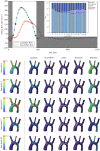Hodge decomposition of wall shear stress vector fields characterizing biological flows
- PMID: 30891301
- PMCID: PMC6408383
- DOI: 10.1098/rsos.181970
Hodge decomposition of wall shear stress vector fields characterizing biological flows
Abstract
A discrete boundary-sensitive Hodge decomposition is proposed as a central tool for the analysis of wall shear stress (WSS) vector fields in aortic blood flows. The method is based on novel results for the smooth and discrete Hodge-Morrey-Friedrichs decomposition on manifolds with boundary and subdivides the WSS vector field into five components: gradient (curl-free), co-gradient (divergence-free) and three harmonic fields induced from the boundary, which are called the centre, Neumann and Dirichlet fields. First, an analysis of WSS in several simulated simplified phantom geometries (duct and idealized aorta) was performed in order to understand the nature of the five components. It was shown that the decomposition is able to distinguish harmonic blood flow arising from the inlet from harmonic circulations induced by the interior topology of the geometry. Finally, a comparative analysis of 11 patients with coarctation of the aorta (CoA) before and after treatment as well as 10 control patients was done. The study shows a significant difference between the CoA patients before and after the treatment, and the healthy controls. This means a global difference between aortic shapes of diseased and healthy subjects, thus leading to a new type of WSS-based analysis and classification of pathological and physiological blood flow.
Keywords: Hodge decomposition; vector field analysis; wall shear stress.
Conflict of interest statement
The authors declare no competing interests.
Figures













Similar articles
-
Hodge decomposition of vector fields in Cartesian grids.SIGGRAPH Asia. 2024;2024:90. doi: 10.1145/3680528.3687602. Epub 2024 Dec 3. SIGGRAPH Asia. 2024. PMID: 40171496 Free PMC article.
-
Meshless helmholtz-hodge decomposition.IEEE Trans Vis Comput Graph. 2010 Mar-Apr;16(2):338-49. doi: 10.1109/TVCG.2009.61. IEEE Trans Vis Comput Graph. 2010. PMID: 20075492
-
A Eulerian method to analyze wall shear stress fixed points and manifolds in cardiovascular flows.Biomech Model Mechanobiol. 2020 Oct;19(5):1403-1423. doi: 10.1007/s10237-019-01278-3. Epub 2019 Dec 21. Biomech Model Mechanobiol. 2020. PMID: 31865482
-
Coronary arteries hemodynamics: effect of arterial geometry on hemodynamic parameters causing atherosclerosis.Med Biol Eng Comput. 2020 Aug;58(8):1831-1843. doi: 10.1007/s11517-020-02185-x. Epub 2020 Jun 9. Med Biol Eng Comput. 2020. PMID: 32519006
-
How does hemodynamics affect rupture tissue mechanics in abdominal aortic aneurysm: Focus on wall shear stress derived parameters, time-averaged wall shear stress, oscillatory shear index, endothelial cell activation potential, and relative residence time.Comput Biol Med. 2023 Mar;154:106609. doi: 10.1016/j.compbiomed.2023.106609. Epub 2023 Jan 23. Comput Biol Med. 2023. PMID: 36724610 Review.
References
-
- Chatzizisis YS, Coskun A, Jonas M, Edelman E, Feldman C, Stone P. 2007. Role of endothelial shear stress in the natural history of coronary atherosclerosis and vascular remodeling: molecular, cellular, and vascular behavior. J. Am. Coll. Cardiol. 49, 2379–2393. (10.1016/j.jacc.2007.02.059) - DOI - PubMed
Associated data
LinkOut - more resources
Full Text Sources
Other Literature Sources
Research Materials

